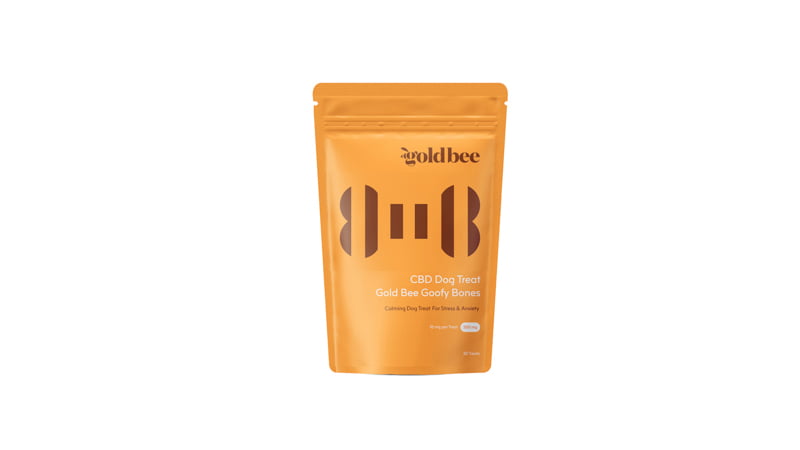Best CBD Dog Treats for Joint Pain

Dog owners often choose CBD dog treats to manage joint pain in their four-legged friends.
It’s no wonder products like CBD dog treats are gaining popularity. After all, CBD is a remarkable anti-inflammatory that can also change the strength of pain signals being sent to the brain.
These two properties make CBD dog treats an appealing alternative to conventional meds prescribed by veterinarians to address joint pain.
Unfortunately, not all CBD dog treats for joint pain are made the same. There’s a large degree of difference when it comes to the quality of such products because the market remains unregulated.
In this article, I’ll provide you with top picks for the best CBD dog treats. I’ll also share more information about the health benefits of CBD for joint pain — and how to choose the right product for your pup.
Best CBD Dog Treats for Joint Pain
1. Royal CBD
| Pros | Cons |
|
|
The Royal CBD dog treats are formulated with all-natural ingredients and sourced from non-GMO hemp to maximize the benefits of CBD for joint pain while providing your dog with safe and biologically appropriate supplements.
There are three versions of CBD dog treats in Royal CBD’s collection, each containing different supportive ingredients:
- Active Treats: Boswellia, Turmeric, Hemp Seed, CBD
- Calming Treats: Chamomile, L-theanine, Hemp Seed, CBD
- Hearty Treats: Blueberries, Flaxseed, Hemp Seed, CBD.
For joint pain, I recommend the “Active” option because it contains turmeric, which helps enhance the immune system and curb inflammation in your dog.
2. Gold Bee
| Pros | Cons |
|
|
Gold Bee follows the same philosophy in making CBD dog treats as it does for its line of human products. These soft chews contain the same premium-quality full-spectrum extract that increases the overall efficacy of CBD by leveraging the entourage effect between all active compounds in hemp.
If your dog doesn’t like the taste of CBD oil, the Gold Bee Goofy Bones could be a decent alternative. Each treat comes with 5 mg of CBD infused with chamomile, 5-HTP, and L-theanine.
This product is good not only for joint pain but also for the days when your dog has a low mood due to inflammation and compromised mobility.
Why You Should Give CBD Treats to Dogs With Joint Pain
A 2018 study found that an oral solution infused with CBD lowered inflammation markers and helped dogs with osteoarthritis — suggesting that CBD might be a promising treatment for dogs with joint pain.
Inflammation is the most common cause of joint pain besides the extensive wear and tear your dog may experience after certain activities.
When left untreated, the inflammation may cause the joint pain to become chronic — contributing to the development of arthritis.
The anti-inflammatory properties have been mentioned in multiple human and animal studies, suggesting it can treat joint pain and associated health conditions.
Although there aren’t many studies that touch on the subject of giving CBD to dogs with joint pain, it’s a well-known fact that all mammals have an endocannabinoid system (ECS) that regulates homeostasis (balance) between all other systems and organs in the body.
Most dog parents give their pets CBD oil for joint pain, but not all dogs fancy the distinct flavor of full-spectrum CBD oils. That’s why some people decide to choose CBD dog treats as the go-to supplements for their buddies.
Wondering how CBD dog treats work for joint pain? Below you’ll find the full explanation.
Does CBD Help with Joint Pain?

Dogs experiencing joint pain can benefit from eating CBD dog treats thanks to the effects of CBD on the ECS.
CBD promotes mobility and helps maintain proper joint function with its anti-inflammatory and antioxidative properties.
The main benefits of giving your dog CBD treats for pain are:
- Reduced inflammation: more and more studies are pointing to cannabinoids as novel anti-inflammatory drugs. Inflammatory processes fuel joint pain, so reducing inflammation is essential for bringing your pup back to shape.
- Weakened pain signals: current research body supports the analgesic properties of CBD. Dogs that eat CBD treats for joint pain may experience less discomfort, especially when moving.
- Better mood: chronic joint pain can negatively impact your dog’s health, including episodes of anxiety and low mood. Studies are indicating that CBD has anti-anxiety and antidepressant effects on dogs thanks to its interaction with the ECS, serotonin receptors, and the ability to increase the neuroplasticity of the brain.
Last but not least, CBD helps to optimize your dog’s ECS over time, leveling deficiencies and helping to restore homeostasis in the body. This, in turn, may translate into overall improvements in their well-being, including better appetite and helps with your dog’s upset stomach, increased mobility, mood elevation, and higher pain threshold.
How CBD Works for Joint Pain
Again, most of the therapeutic effects of CBD are manifested through its modulation of the ECS.
The ECS is a vast neurochemical network responsible for regulating essential processes within the body, including pain perception, immune function, sleep cycles, memory, mood, body temperature, appetite, hormonal balance, reproduction, neurogenesis, and more.
When the ECS and its components (receptors, endocannabinoids, and enzymes) work in harmony, the other systems, organs, and tissues can also perform their functions without any disturbances.
But, once the ECS goes out of whack — be it due to environmental factors, traumas, or other events — your body loses stability, potentially leading to the development of various physiological and mental disorders.
A dysfunctional ECS has been linked to conditions such as type 1 diabetes, migraines, irritable bowel syndrome, post-traumatic stress disorder (PTSD), fibromyalgia, and different types of dementia.
All mammals — including dogs — have this system; moreover, it works the same across every species on this planet.
Back to its components, the ECS has two types of receptors, CB1 and CB2.
CB1 receptors are highly concentrated in the brain and central nervous system, while CB2 receptors dominate the immune system and peripheral organs.
Both receptors are involved in pain, but the CB1 receptor is more in charge of pain signals, while CB2 controls immune response, regulating inflammation.
Endocannabinoids are neurotransmitters that bind to cannabinoid receptors or indirectly modulate their activity — resulting in specific actions within the body and brain.
A study from the journal Future Medicinal Chemistry found that inflammatory responses can be reduced by adding CBD to one’s routine due to its ability to interact with the ECS.
This has given rise to a hypothesis that CBD and other cannabinoids from cannabis can help in the management of autoimmune conditions that involve chronic inflammatory pain.
Unlike THC, CBD is non-intoxicating, so it won’t get your dog high. Hemp-derived CBD dog treats for joint pain contain 0.3% THC or less; thus, dog owners don’t need to worry about the so-called marijuana toxicity.
CBD Oil vs Treats: Which is Better for Joint Pain?
It depends on your dog’s attitude towards the taste of CBD oil. In one survey, 50% of dog owners admitted to giving their dogs CBD treats instead of CBD oil because the treats are much tastier and the dog doesn’t need to hold them inside their mouth for a specific amount of time.
High-quality CBD dog treats for pain are often infused with supportive natural ingredients, such as sweet potato, turmeric, Boswellia, apple, blueberries, and hemp seeds. All of these compounds are known to provide anti-inflammatory effects, which can further bolster your dog’s immune system.
You may also consider other health supplements that will support your dog’s mobility, such as glucosamine HCL, chondroitin, and omega-3 essential fatty acids.
That being said, CBD dog treats have one potential con — the onset time of CBD, which is delayed compared to oils. That’s because CBD needs to pass through the digestive system and then get metabolized in the liver before being released into the bloodstream.
While the effects of CBD dog treats usually kick in within 40 minutes to 2 hours after consumption, CBD oil produces them faster — in about 15–30 minutes.
But, if the dog is repelled by the very smell of CBD oil, there’s no point in forcing them to ingest it. That’s where CBD dog treats become a viable alternative for managing joint pain.
Recommended CBD Treats Dosage for Your Dog’s Joint Pain

The problem with the CBD market is that hemp-derived CBD oils aren’t officially acknowledged medications, unlike isolated cannabinoids that have been turned into drugs (e.g. Epidiolex, Marinol, Dronabinol, Sativex).
Therefore, CBD oils and dog treats don’t have official dosage charts or recommendations for joint pain.
Fortunately, reputable manufacturers provide dosing instructions on the packaging of their products, giving dog parents a general idea of where to start and how many treats they should feed their dogs with.
A study run by Colorado State University suggested giving dogs 2 mg of CBD per kilogram of their body weight to increase physical comfort and activity.
You can also follow the dosage guidelines laid out by Veterinary Cannabis Education and Consulting.
The general rule of thumb is to start low and slowly increase the amount of CBD treats to the point where your dog experiences relief from joint pain without showing any adverse reactions.
If you’re not sure how many dogs treats you should give your buddy, follow the dosing instructions and serving sizes on the pouch. Monitoring the results and taking notes will help you gauge the right dosage after a few attempts.
How to Find the Best CBD Dog Treats for Joint Pain
If you’ve never tried giving CBD treats to your dog, you’re probably puzzled and have no idea where to start, especially with so many different local and online CBD dog treats brands to choose from
Follow these simple steps and you’ll be able to separate the wheat from the chaff in no time:
- Check the hemp source: hemp plants have bioaccumulative properties, so they will draw up every substance from the soil, including the nutrients and potential toxins. The best CBD dog treats for joint pain come from non-GMO, pesticide-free hemp that has been grown on US farms. That’s because American farmers need to abide by strict regulations set out by the United States Department of Agriculture (USDA).
- Choose CO2-extracted products: CO2 extraction is the best method to pull the therapeutic compounds from the plant material without adding extra heat or using dangerous solvents that are difficult to purge. CO2-extracted CBD dog treats are pure and maintain consistent potency between batches, making this technology the golden standard.
- Ask for Certificates of Analysis (COA): CBD companies can send samples of their products to a third-party laboratory for complete testing, including the product’s potency and purity. The certificate of analysis from such testing should contain results for pesticides, heavy metals, mycotoxins, and solvents on top of the phytochemical profile.
- Watch out for “hemp oils”: since the CBD market is unregulated, many CBD products for pets are mislabeled and often contain little to no CBD at all. The most popular CBD scam involves infusing dog treats with hemp seed oil instead of a full-spectrum hemp extract. Hemp seed oil, while very nutritious, doesn’t contain any cannabinoids, so it will be useless if you want your dog to reap the benefits of CBD.
- Read user reviews and testimonies: trustworthy CBD companies will do everything in their power to ensure top-notch customer service and deliver high-quality products. These companies usually have good reviews on websites like Better Business Bureau (BBB) or TrustPilot. They also have customer-friendly return programs and a working live chat.
You can also bake some homemade CBD dog treats yourself if you don’t trust the store-bought ones. They’re super easy to make and the internet is full of great recipes for healthy dog chews.
Pros & Cons of Using CBD for Joint Pain
The Pros
- CBD dog treats come with a fixed amount of CBD per serving. You don’t need to make any measurements yourself.
- CBD dog treats also contain different superfoods that may potentiate the effects of CBD
- The effects of CBD dog treats on joint pain last longer than CBD oils because the CBD is gradually released from the liver into the bloodstream. You may expect them to last for around 10–12 hours.
- The anti-inflammatory and analgesic effects of CBD are well documented in the scientific literature. It uses several different mechanisms to achieve them, hence its potential to treat pain-related conditions.
- CBD has an excellent safety profile. It only has mild side effects when taken in extremely high doses, such as tiredness, dry mouth, changes in appetite, and diarrhea.
- Like humans, dogs have an endocannabinoid system that corresponds with plant-derived cannabinoids. Therefore, they could reap similar benefits from their supplementation.
The Cons
- The majority of evidence supporting CBD’s effects on joint pain comes from human and rat studies. Only a few studies have been conducted specifically on dogs suffering from joint pain and compromised mobility.
- CBD dog treats have a delayed onset because they’re metabolized in the digestive tract first. The effects of CBD dog treats may be delayed by 30 minutes up to 2 hours.
- The CBD space is unregulated, so you need to keep an eye out for scammers disguised as premium companies. Make sure to always do your research on any vendor out there — using my buyer’s guide from above.
How CBD Compares to Other Treatments for Joint Pain

CBD dog treats are considered a health supplement that can improve canine joint health and mobility. However, veterinarians usually don’t prescribe them as the first-line treatment.
Vets commonly recommend pain pills like non-steroidal anti-inflammatory drugs (NSAIDs) that are supposed to curb inflammation and ease joint pain in dogs.
However, this category of drugs may have severe adverse effects on dogs, especially on older ones.
In a systematic review of NSAID effects on dogs, the most commonly reported side effects were vomiting, diarrhea, and anorexia.
For that reason, dog parents are looking for alternative treatments for joint pain, including exercise, dietary modifications, osteopathy, and healthy supplements like CBD dog treats.
Being overweight increases a dog’s risk of experiencing joint pain, which is why maintaining a healthy weight is the number one priority on the dog parents’ list.
As it turns out, CBD may have a positive effect on the metabolism on canine metabolism.
A 2012 study on rats showed that subjects who took CBD had reduced food intake compared to the non-CBD group.
Another study found that CBD initiates the process known as “gat browning,” where white fat cells (the ones that store energy) turn into fat brown cells (ones that burn it).
When it comes to dietary modifications, it’s important to provide your dog with high-quality animal-derived protein and take care of the proper ratio of omega-3 to omega-6 fatty acids. Steer clear of high-carb dog food that is filled with preservatives, colorings, and flavor enhancers.
Other common health supplements for dogs and their joint health include glucosamine and chondroitin, both of which are safe for animals.
Glucosamine is naturally produced by the body. Veterinarians may use this supplement as an alternative for treating osteoarthritis in dogs. However, there’s little research to support the use of glucosamine for joint pain.
Why Do Dogs Suffer from Joint Pain?
Dogs may experience joint pain for several reasons. Most of the time, it’s just regular joint pain that results from wear and tear or injuries, but sometimes, it may indicate a serious health condition, such as arthritis.
Joint pain can be caused by the following factors:
- Traumatic Accidents: physical trauma can negatively impact the health of your dog’s joints. Dislocation or fracturing of the ankle may occur during exercises and regular physical activity, leading to further disorders later in life.
- Kneecap Displacement: it can occur at any age and is regarded as deformation of the femur, hip joint, tibia, and hindlimb — increasing the risk of cartilage damage in the knee.
- Osteochondrosis: a cartilage tissue and bone malformation most commonly found in growing dogs. It’s also the main risk factor for degenerative joint disease.
- Infection: joint pain may also stem from infections such as septic arthritis. This condition involves the growth and spread of bacteria through the blood, which can be caused by trauma or surgery. Lyme disease and Rickettsia are the most common joint diseases resulting from an infection.
- Aseptic Necrosis of the Femoral Head: this one occurs more often in young breeds or breeds of miniature dogs. The main sign is a limited blood supply to the bones, which is most of the time attributed to a malfunction of the breed.
- Elbow or Hip Displacement: it can happen to dogs younger than one-year-old. The condition is defined as an abnormal growth of the elbow joint in young, quickly developing dogs. Osteoarthritis is the most common consequence of this displacement.
- Degenerative Joint Disease: after being constantly exposed to damage from any of the aforementioned conditions, degenerative disorders may occur, resulting in secondary osteoarthritis. Other potential causes include autoimmune conditions and joint degeneration after tearing a cruciate ligament.
Signs of Joint Pain in Dogs
Mobility is the first area of your dog’s health that gets affected by joint pain. So, if you want to figure out whether your dog’s joints are in good condition, make sure to monitor its mobility.
Common symptoms of joint pain in dogs include:
- Behavioral changes: apathy, aggression, or depression
- Constant licking or gnawing on tender areas to change the direction of pain.
- Hesitation to move, jump, run, etc.
- Lethargy and a tendency to sleep longer to avoid physical activity
- Limping. At first, it may be an almost unnoticeable limp but may become more apparent over time as your dog gets tired.
- Strange posture triggered by inflammation, spinal pain, and backaches.
If you believe your dog is in pain, take them to the vet immediately. The veterinarian will help evaluate your dog’s health to find the source of discomfort and address the problem.
Monitoring Your Dog’s Mobility is One of the Best Ways to Determine Joint Pain

CBD dog treats are a decent option for managing joint pain as an alternative to conventional methods. However, they’re not the only effective tool out there.
Here’s what you can do to improve your dog’s joint health aside from giving them CBD treats:
- Physical Therapy – this approach will help manage painful flare-ups in the joints. There are various resources, but swimming and underwater treadmills are among the best methods.
- Weight Management – I’ve already covered this one briefly, but let’s make it clear once again: ensure the proper intake of lean protein, good fats, and provide your dog with essential nutrients, such as healthy omega fatty acids, vitamin A, B, C, E, minerals, and other important compounds. Avoid junk food at all costs.
- Other Supplements for Joints – there are a lot of dietary supplements that are aimed at improving canine joint health, ranging from glucosamine to fish oil, MSM, and hyaluronic acid. These supplements are often available in canine-friendly flavors, such as peanut butter, cheese, or bacon.
- Prescription Medications – this option should be used only if the dog needs immediate medical intervention and the pain is too severe to be handled with natural ingredients. Examples include post-surgical pain, severe injuries, or advanced arthritis flare-ups.
Summarizing the Best CBD Dog Treats for Joint Pain & Their Benefits
The anti-inflammatory and analgesic properties of CBD are well-documented in the scientific literature. CBD achieves these effects by interacting with the endocannabinoid system, which is the master regulatory network that performs the same functions across all mammals.
The ECS regulates a lot of essential bodily functions, including immune responses and pain signaling.
Although only a few studies have investigated the efficacy of CBD for joint pain — and none of them involved dog treats — research on rat and human models is very promising.
And considering that the ECS is the same in humans and dogs, it’s only within reason to assume that our canine friends may reap similar benefits from using CBD.
If you’re looking to add CBD dog treats to your dog’s routine for joint support, make sure to run a thorough background check on your potential vendor. And if you don’t have time for that, feel free to use my recommendations from this guide. Both Royal CBD and Gold Bee make high-quality dog treats that can ease your dog’s joint pain thanks to the high potency of CBD and other supportive ingredients.
Sources:
- Gamble, L. J., Boesch, J. M., Frye, C. W., Schwark, W. S., Mann, S., Wolfe, L., Brown, H., Berthelsen, E. S., & Wakshlag, J. J. (2018). Pharmacokinetics, Safety, and Clinical Efficacy of Cannabidiol Treatment in Osteoarthritic Dogs. Frontiers in veterinary science, 5, 165. https://doi.org/10.3389/fvets.2018.00165 [1]
- Nagarkatti, P., Pandey, R., Rieder, S. A., Hegde, V. L., & Nagarkatti, M. (2009). Cannabinoids as novel anti-inflammatory drugs. Future medicinal chemistry, 1(7), 1333–1349. https://doi.org/10.4155/fmc.09.93
- Russo E. B. (2008). Cannabinoids in the management of difficult to treat pain. Therapeutics and clinical risk management, 4(1), 245–259. https://doi.org/10.2147/tcrm.s1928
- Blessing, E. M., Steenkamp, M. M., Manzanares, J., & Marmar, C. R. (2015). Cannabidiol as a Potential Treatment for Anxiety Disorders. Neurotherapeutics: the journal of the American Society for Experimental NeuroTherapeutics, 12(4), 825–836. https://doi.org/10.1007/s13311-015-0387-1 [4]
- Zou, S., & Kumar, U. (2018). Cannabinoid Receptors and the Endocannabinoid System: Signaling and Function in the Central Nervous System. International journal of molecular sciences, 19(3), 833. https://doi.org/10.3390/ijms19030833 [5]
- Ibid.
- Convenience Store News. (2021). Half of the U.S. Pet Owners Use CBD for Their Animals. Convenience Store News. Available from: https://www.csnews.com/half-us-pet-owners-use-cbd-their-animals
- Bartner, L. R., McGrath, S., Rao, S., Hyatt, L. K., & Wittenburg, L. A. (2018). Pharmacokinetics of cannabidiol administered by 3 delivery methods at 2 different dosages to healthy dogs. Canadian journal of veterinary research = Revue canadienne de recherche veterinaire, 82(3), 178–183. [8]
- Monteiro-Steagall, B. P., Steagall, P. V., & Lascelles, B. D. (2013). A systematic review of nonsteroidal anti-inflammatory drug-induced adverse effects in dogs. Journal of veterinary internal medicine, 27(5), 1011–1019. https://doi.org/10.1111/jvim.12127
- Farrimond, J. A., Whalley, B. J., & Williams, C. M. (2012). Cannabinol and cannabidiol exert opposing effects on rat feeding patterns. Psychopharmacology, 223(1), 117–129. https://doi.org/10.1007/s00213-012-2697-x
- Buckley, J. D., & Howe, P. R. (2010). Long-chain omega-3 polyunsaturated fatty acids may be beneficial for reducing obesity-a review. Nutrients, 2(12), 1212–1230. https://doi.org/10.3390/nu2121212
- Johnston C. S. (2005). Strategies for healthy weight loss: from vitamin C to the glycemic response. Journal of the American College of Nutrition, 24(3), 158–165. https://doi.org/10.1080/07315724.2005.10719460
- Freire R. (2020). Scientific evidence of diets for weight loss: Different macronutrient composition, intermittent fasting, and popular diets. Nutrition (Burbank, Los Angeles County, Calif.), 69, 110549. https://doi.org/10.1016/j.nut.2019.07.001 [13]

